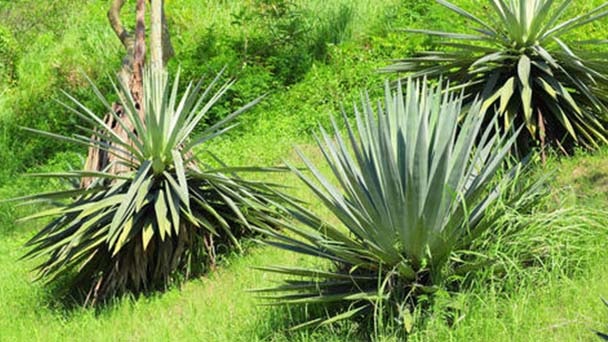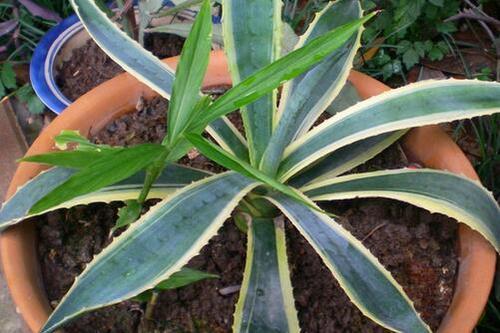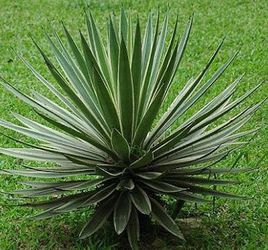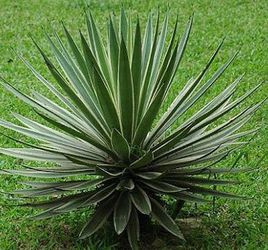Agave profile
Written by Maggie
Jan 21 2021

Agave is a large perennial evergreen herb, originally from Mexico. Because of its strong leaves, evergreen, for the southern garden layout of one of the important materials, the Yangtze River Basin and the north of the greenhouse. Agave like well - drained, fertile and moist sandy soil. The place of origin generally takes several decades to blossom, after flowering, the mother plant dies, cross-pollination can bear fruit.
Agave picture

Morphological characteristics of Agave
Leaf
Agave (Agave Americana L.) is a perennial plant. Agive is a perennial evergreen plant with tall plants. Agave leaves are arranged in rosette, usually 30-40, sometimes 50-60. They are large, fleshy, oblong-lickle-shaped and linear, L-2 meters long, 15-20 cm wide in the middle, 10-12 cm wide in the base. The leaf margin is sparsely spiny, and there is a sharp prickle at the top, which is dark brown, and 1.5-2.5 cm long.
The leaves of Agave are grey-green or blue-gray, up to 1.7 m long and 20 cm wide, arranged in a rosette at the base. Leaf-margin spines are brown at first, then grayish white, with terminal spines up to 3 cm long. Pedicels are drawn from the center of the rosette, yellow-green flowers.
Flowers
Agave is a large panicle, 6-12 meters long, with many branches; Yellow-green; Perianth tubes ca. is 1.2 cm long, perianth lobes 2.5-3 cm long; Stamens are about twice as long as perianth.
Fruit
The capsule of Agave is oblong, about 5 cm long. Very few beadles are formed on the inflorescence after flowering.
Agave blooms in summer.
Ecological habits of Agave
Agave likes full sunshine, and is slightly cold resistant and not shade tolerant. Agave likes a cool, dry environment, suitable for growth temperature 15 to 25℃; It grows best at night temperature of 10-16 ℃, and can be cultivated in the open field at temperature above 5℃. Under low temperature of minus 5℃, the leaves of adult Agave are only slightly damaged by freezing, and the aboveground parts are frozen and rotted at minus 13℃, and the underground stem will not die. It can sprout and develop leaves in the next year and grow normally. Cold and dry winter is most favorable to its growth. Agave has strong drought resistance; To the soil requirement is not strict, with loose, fertile and the moist sandy soil with good drainage is appropriate.
Growing method of Agave
Sunlight
The original growth environment of Agave often has quite hot sunshine. Therefore, Agave is very adaptable to the environment with abundant sunshine. If there is not enough sunshine in the environment, the growth of the plant will not be good and the original charm will be lost. Therefore, in winter, the sunshine condition is relatively poor, so special attention should be paid to the sunshine condition of the cultivation environment of Agave, and sufficient sunshine should be provided as far as possible, so as to benefit the growth of Agave and make it past the winter safely.
The temperature
Agave has hard vitality, which of course also means that Agavee can endure relatively harsh environments. In the south, even when the cold wave comes, as long as there is sufficient sunshine, Agave can adapt to it. The lowest growth temperature of Agive is about 7℃, so when the temperature is too low, it should be moved to indoor curing, and the rest of the time can just be cultivated outdoors.
Watering
Agive has a strong nature and does not have a strict requirement on water. However, sufficient water must be provided during its growth period for it to grow well.In addition, during the dormant period in winter, Agave should not be watered with too much water, otherwise it is likely to cause root rot.
Fertilization
Due to the strong adaptability of Agave to the environment, the growth of the plant will not be affected even if it grows on a rather poor soil. However, fertilisation of the medium will still make Agave grow better. The number of fertilization once a year is appropriate, do not often spray fertilizer, otherwise it is easy to cause fertilizer damage.
Pot soil and change pots
The growth rate of Agave is very slow, so it is not necessary to change the pot frequently. If you often appreciate it, it will not help the plant, but will make the growth potential of Agave worse. Agave is more suitable for dry environments, so its pot soil should adopt sandy soil with good drainage.
Note: fertilizing once a month during the growing period. Increase the amount of water in summer to keep the leaves green and tender. For theAgave with white or yellowedges, shade slightly in the hot sun.

Agave's way of propagation
Most species of Agave plants only bloom once in their life, and then gradually die as the seeds mature. Agave generally accumulates nutrients for many years, and then suddenly sprouts and grows wildly. However, this would deplete all of its energy, and the Agave would wither and die soon after it exploded. And some precious varieties are difficult to blossom, so in the production of common division, cuttings, sowing methods for reproduction.
Division propagation
More in the growing season, often can be combined with spring for basin. Remove the seedlings that germinate at the base of the old plant, and plant them in pot directly with or without roots.
Cutting propagation
In the growing season, take off the buds that germinate in the axils of leaves, hang them for 5 ~ 7 days, and plant them in the culture soil with good drainage and air permeability after the wound is dry. It is easy to take root and survive.
Seed propagation
Seeds can also be sown and reproduced if they can be collected. Sowing reproduction has a fairly high rate of seedling emergence and seedling management is not difficult. The optimal germination temperature of seeds is more than 15℃ at night and about 30℃ in the day. If the temperature is lower than 10℃ at night and 20℃ in the day, the germination rate of seeds will be greatly reduced and even can not sprout. After sowing, cover the surface of the basin with transparent glass for heat preservation and moisture, and the seedlings can emerge 7 ~ 10 days after sowing.
Disease control of Agave
Agave often occurs leaf spot disease, anthrax and gray mold, can be sprayed with 50% bacteria-free special wettable powder 1000 times liquid. If scale insect harm, use 80% dichlorvos emulsion 1000 times liquid spray kill.
The main value of Agave
Beautify the environment
Agave leaves are strong and beautiful, evergreen all the year round, and there are many varieties of horticulture.It is often used for potted plants or flower grooves. It is suitable for arranging small courtyards and halls. It is planted in the center of flower beds and a corner of lawn, which can add tropical scenery.
Control decoration pollution
In a room of about 10 square meters, 70% of benzene, 50% of formaldehyde and 24% of trichloroethylene can be eliminated. Because the newly decorated house has been constantly releasing harmful gases such as formaldehyde, so environmental experts suggest that after the decoration, keep more ventilation, keep a few pots of Agave, and use some Maya blue, which can basically meet the occupancy standard after three to six months of vacancy.
Ecological greening decoration
Agave fits nicely in the living room.It is simple but noble. No matter what style of decoration, you can choose the appropriate size of Agave to place on the table cabinet or the corner of the sofa, or you can use the hanging potted Agave to hang in the living room. You can see the green without being disorganized or impeding your family's activities.

Latest Updated
- Benefits of Bugleweed - 7 Science-backed Health Benefits
- Bugleweed Dangers & Side Effects - Is It Poisonous?
- How to Plant Evergreen Trees - What You Should Know
- When to Plant Evergreens - Grow Guide for Evergreen Trees
- 12 Wonderful Evergreen Shrubs for Your Garden
- 12 Popular Evergreen Plants with Pictures for Beginners
- When And How To Prune A Lilac Bush Like a Pro
- How to Grow & Care for Lilac Vine (Hardenbergia Violacea)
- Japanese Lilac Tree (Syringa Reticulata) Care & Propagation Guide
- Shumard Oak Pros and Cons - What to Know
Popular Articles
- Winter maintenance of Antirrhinum Majus
- How to Grow Terminalia Mantaly Tree
- How to Grow and Care for Crossostephium Chinense
- How to grow Antirrhinum Majus in spring
- Peristeria Elata (Dove Orchid) Profile: Info & Care Guide
- Underwatered Snake Plant (Sansevieria Trifasciata) - Signs And How To Fix
- How to Care for Brazilian Jasmine Plant (Mandevilla Sanderi)
- How to Grow & Care for Graptopetalum Purple Delight in Summer
- Rosa Chinensis (China Rose): Plant Growing & Care Tips
- How to Care for Baby Sun Rose (Aptenia Cordifolia)